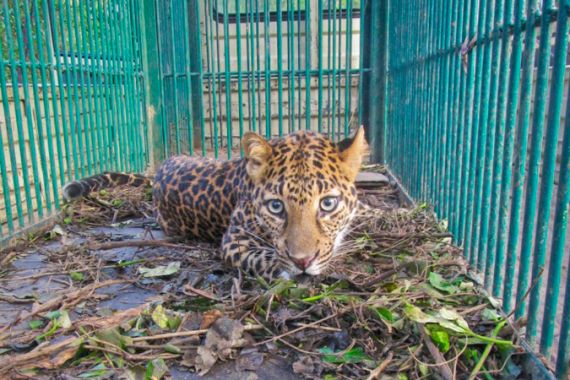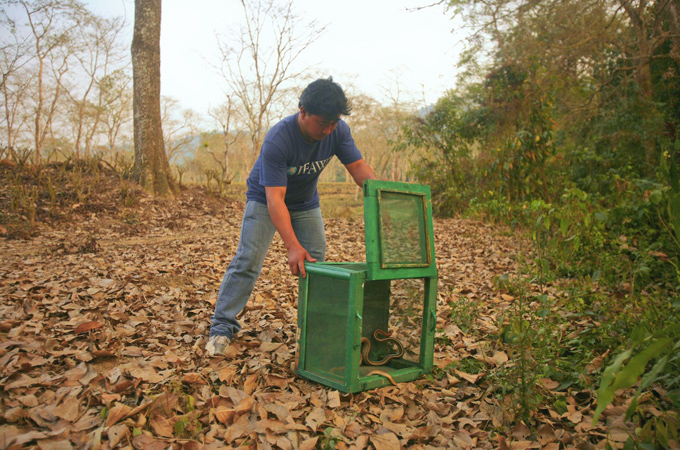Human-animal conflict leaps up in India
In Assam state, development and habitat loss are forcing wildlife into urban areas.

Guwahati, India – Each time the sepia-coloured snake hisses, Pronita Kashyap says, “Aastik, Aastik, Aastik” – a prayer to the Hindu serpent goddess and her son.
Sweaty and jittery, she explains, “It is said that snakes kill by fate and tigers by chase”. When the snake coils and recoils at the corner of a squat toilet, Kashyap sprinkles smashed garlic and sprays a disinfectant on the floor, hoping to drive the half-metre-long intruder from her home. Stick in hand, she calls the state animal zoo – but there’s no response.
Keep reading
list of 4 itemsAfter the Hurricane
World’s coral reefs face global bleaching crisis
Why is Germany maintaining economic ties with China?
About half an hour later, the snake slithers out through the window into the garden. Kashyap keeps watching until the weeds and reeds stop quivering.
As forest cover shrinks in India’s northeastern state of Assam, sightings of wild animals have become increasingly common. According to the National Crime Records Bureau, 290 people were killed by animals in Assam from 2009-11 – second only to Maharashtra state.
Human-animal conflict is widespread in rural areas in Asia and Africa, but habitat loss and development in places like Assam have put more people in urban areas at risk.
In the past few years, reports have abounded of pythons entering bathrooms and bedrooms, sambar deers running through courtyards, clouded leopards sneaking into backyards at night and carrying off livestock or pets. Pangolins, jungle cats, civet cats, foxes and wild boars repeatedly stray onto the lanes and bylanes of Guwahati, the capital. Monkeys running amok in kitchens is a routine occurrence in hillside areas. Outside of the city, elephants, tigers, one-horned rhinos and gaur, the Indian bison, are occasionally spotted.
These human-animal encounters often result in panic, fracas and bloodshed.
Shrinking habitat
As man encroaches on wilderness, the wild strays into urban settlements. This is not an overnight development, says Jayanta Sarma, an environmental consultant.
 |
| The Assam state zoo has rescued 324 animals from in and around Guwahati, the capital, from April 2012 to March 2013 [Sashanka/IFAW-WTI] |
Assam’s population swelled from 14 million in 1971 to 31 million in 2011. Frenzied urbanisation gobbled up 30 percent of the state’s forestland. Nationally, Assam has the most forestland under encroachment.
“There has been a prolonged conflict between so-called development and conservation of wildlife,” explains Sarma. The line between urban, rural and jungle is becoming blurry in Assam, a tropical biodiversity hotspot.
Illegal deforestation, logging, earth-cutting and extension of residential settlements and croplands into reserved forests and hillocks have reduced the natural habitat of animals, forcing animals to wander around in search of food.
When stray wild animals devour domestic ones, there is no compensation for owners. When vengeful crowds slay feral animals, there is no punishment, encouraging such killings, adds Sarma.
Rescue teams
Between April 2012 and March 2013, the Assam state zoo has rescued 324 animals from in and around Guwahati, the capital, according to Dr M L Smith, a forest veterinary officer. Of these, 54 died, 45 were exhibited at zoos and 225 were released in protected areas.
The zoo has no specific rescue team, and the officials, animal-keeper and veterinary doctors respond to distress calls. Many animals die during rescue attempts or from being trapped in wells; one leopard died from an overdose of tranquiliser. Irate locals have killed many straying animals with rocks, axes or bamboo poles. In March 2012, mobs butchered two leopards – one in Kamrup and the other in Dibrugarh district – and feasted on their meat.
In January, the state government announced the deployment of rapid-rescue teams in 15 districts. “None of the teams are operational,” says Anjan Talukdar, a veterinarian at IFAW-WTI, Center for Wildlife Rehabilitation and Conservation, based in Kaziranga. He says media – particularly television channels – provoke the crowds and cause a nuisance. “At least 1,000 people gather out of curiosity and it hampers the rescue operation,” he explains.
The IFAW-WTI centre has five mobile teams and has rescued more than 3,306 animals in the last 10 years in Assam and released 1,854, according to Rathin Barman, the coordinator of the centre. It receives an average of 30 calls a month and during monsoon season about 200.
No winner in this tussle
Feverish urbanisation has muddled the food chain and positioned man in the path of animals’ migration routes, says Rajib Rudra Tariang, a professor of zoology at Digboi College. “Now there is more collision and people have become volatile,” he explains.
The close encounters have left residents of Assam wary. A muddy road leads to Mridula Borah’s house, perched on the foothills of Durga Sarobar in Guwahati. A few years ago, the hill was covered with dense forests, but now it is a haphazard patchwork of ranch-style houses, clusters of trees and large egg-shaped rocks.
“We regularly hear the roar of leopards at night, and there is a strong musky smell,” Borah says. Once the street was full of stray dogs, but now there are none. The community has started keeping pets indoors after many were killed.
Borah’s two-year-old cocker spaniel, Olive, was taken one night. In the morning, Borah found dried blood and leopard pawmarks on the soft, red soil.
This story has been written under the aegis of the CSE Media Fellowships.